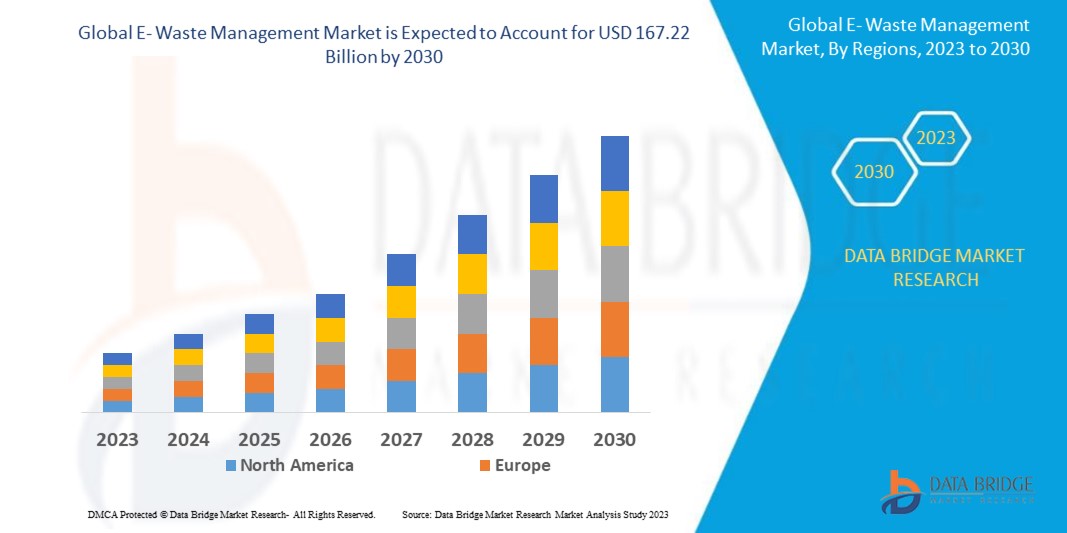The E-Waste Management Market is witnessing substantial growth as the global surge in electronic consumption and increasing awareness around environmental sustainability drive demand for efficient electronic waste recycling and disposal solutions. With the mounting pressure to reduce carbon footprints and recover valuable materials from discarded electronics, stakeholders across industries are investing in advanced e-waste handling technologies.
Market Overview
E-waste, or electronic waste, refers to discarded electronic appliances such as computers, televisions, mobile phones, and other consumer electronics. The rapid pace of technological innovation and decreasing device lifespans have significantly contributed to rising e-waste volumes worldwide. According to industry estimates, the global e-waste volume surpassed 57 million metric tons in 2023, and this figure is projected to increase consistently in the coming years.
Governments and regulatory bodies are introducing stringent policies mandating responsible recycling, while consumers are becoming more eco-conscious. This trend is fueling market expansion, particularly in developed economies and rapidly industrializing nations.
Key Market Drivers
-
Proliferation of Electronic Devices
Increasing digitization, remote work, and smart device usage have led to higher turnover rates of electronic products, generating more e-waste. -
Government Regulations and Initiatives
Regulatory frameworks such as the European Union’s Waste Electrical and Electronic Equipment (WEEE) directive and India’s E-Waste Management Rules are pushing manufacturers and recyclers to adopt sustainable practices. -
Growing Demand for Rare Earth Recovery
Precious metals like gold, silver, palladium, and copper, commonly found in electronics, present a lucrative opportunity for material recovery and reuse. -
Advancements in Recycling Technologies
The adoption of AI-powered sorting systems, robotics, and automated dismantling processes are enhancing recycling efficiency and reducing labor costs.
Market Segmentation
-
By Material Type: Metals, plastics, glass, others
-
By Source: Household appliances, consumer electronics, IT & telecom equipment, industrial electronics
-
By Region: North America, Europe, Asia-Pacific, Latin America, Middle East & Africa
Regional Insights
-
Asia-Pacific dominates the market, led by countries like China and India, which produce the highest volume of e-waste globally due to high population density and growing digital adoption.
-
Europe remains a leader in sustainable e-waste recycling, thanks to strong enforcement of environmental regulations.
-
North America is witnessing increased private investments and public awareness campaigns for responsible e-waste disposal.
Competitive Landscape
Major players in the E-Waste Management Market include:
-
Sims Lifecycle Services
-
Electronic Recyclers International, Inc.
-
Aurubis AG
-
Stena Metall Group
-
Tetronics International
These companies are focusing on mergers, acquisitions, and the development of eco-friendly recycling solutions to gain a competitive edge.
Many rules and policies are being implementing by governments all over the world to manage e-waste efficiently. For instance, the Ministry of Environment, Forests and Climate Change in India has legislated that manufacturers of electronic devices be accountable for recycling and lowering the amount of e-waste in the nation. Several other strategies are also being used, such as adjustments to the production process, renewable resources, and eco-friendly packaging alternatives, to reduce the amount of e-waste. Household appliances make up a sizable amount of the world’s e-waste. As a result pf this, effective rules must now be developed to manage enormous amounts of e-waste. Many countries mandate manufacturers and importers to gather electronic products for end-of-life management. Manufacturers might choose to recycle their own electrical waste or repurpose it. For instance, the Home Appliances Recycling Law in Japan mandates that users of appliances such as air conditioners, refrigerators and washing machines deliver them to stores so that they can send them to businesses. These laws are encouraging an environment where e-waste recycling is possible. Therefore, the increasing government regulations and policies to manage e-waste is expected to drive the market’s growth rate.
The lifespan of electronic gadgets is getting shorter da by day which aids in the manufacturing of inexpensive and accessible products. People are choosing to buy new devices rather mending existing ones because they are substantially less expensive. People regularly switch their old devices for new ones in order to stay current with market trends. This is producing a lot of e-waste and contributing to pollution issues. Additionally, the environment is becoming more toxic due to landfills, seepage of mercury and lead, and the waste of resources like gold, copper, platinum, lithium, and silver, which are needed to make circuits and parts. Such waste could result in a shortage of resources. These metals can be recycled and are recoverable, but the lack of innovation in recycling methods is impeding the recovery. All these above mentioned factors are hampered the market growth during the forecast period.
Future Outlook
The global E-Waste Management Market is projected to reach USD 150 billion by 2032, growing at a CAGR of over 12% from 2024 to 2032. The shift towards a circular economy, increasing public-private partnerships, and the rise of green electronics manufacturing are expected to play pivotal roles in shaping the future of the industry.
Data Bridge Market Research analyses that the E-waste management market is expected to reach USD 167.22 billion by 2030, which is USD 63.79 billion in 2022, at a CAGR of 12.80% during the forecast period.
In addition to the insights on market scenarios such as market value, growth rate, segmentation, geographical coverage, and major players, the market reports curated by the Data Bridge Market Research also include in-depth expert analysis, geographically represented company-wise production and capacity, network layouts of distributors and partners, detailed and updated price trend analysis and deficit analysis of supply chain and demand.
Get More Details:
https://www.databridgemarketresearch.com/reports/global-e-waste-management-market
Conclusion
With growing environmental concerns and regulatory support, the E-Waste Management Market is poised for significant transformation. As businesses and consumers strive for more sustainable practices, the industry is expected to see continued innovation, investment, and global expansion in the coming years.
